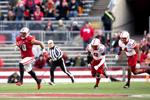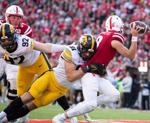LINCOLN — Thanks to NCAA rules changes last week, Nebraska football is free to add as many new players as it wants in the next two recruiting cycles. And the Huskers’ revamped recruiting operation has set up the Big Red with a June full of top-shelf visits.
How many spots will NU have open for 2023?
While the NCAA removed its 25-man cap on the number of scholarship players who can sign during a cycle, it kept the 85-scholarship total in place.
Currently, Nebraska has 10 scholarship seniors, including offensive lineman Kevin Williams, who played two games in 2021 and could petition for an additional year. Even if all 14 juniors left for the NFL after the 2022 season — an unlikely development — that would still be 24 scholarships. And because NU plans to, well, win more games this season, additional players may stick around.
The classroom, if you will, has only so many desks. How does Nebraska manage it?
Does NU look to name, image and likeness to present opportunities that earn up to the cost of tuition, room and board and books? NU’s top collective, Athlete Branding and Marketing, embraced a walk-on initiative earlier this spring.
People are also reading…
“ABM will assist in solidifying Nebraska’s place as the best walk-on program in the country,” ABM President Gerrod Lambrecht said.
Does Nebraska take the commits and figure out its full complement of signings in December or February? It could, knowing players inevitably transfer after the season.
Do the Huskers, after adding at least 14 — perhaps up to 16 — transfers in this cycle, dial their portal usage to zero for 2023? Iowa added one transfer in 2022. So did Clemson. So did Stanford. Texas A&M added two. Georgia, according to the 247Sports transfer tracker, didn’t add any.
At some point, should Nebraska stabilize and start winning more games, it likely wants to find a recruiting diet that features more players through the “draft” and fewer through “free agency.” The double whammy of COVID-19 and the collapse of NU’s recent recruiting classes — 14 of 26 signees from the 2020 class already left — meant the Huskers had to find rapid answers in the portal, especially in the secondary and defensive line.
If Nebraska’s talent acquisition operation were still at 2021 levels, there may not have been a dilemma. That group of coaches had lost its mojo.
Special teams coordinator Bill Busch said last week that NU now has a high-octane motor full of revved-up recruiters and an organizer in Senior Director of Player Personnel Vince Guinta, who’s good at handling the heat.
“He’s a very calming personality with a lot of Type A personalities,” Busch said. “That’s just coaches, right? Me included. They organize everyone.”
The plan’s in place. How many commits can NU take?
What makes good recruiter?
Left on the cutting room floor of my Friday recruiting story was a question to Busch about what makes a good recruiter. Busch, after all, has been a strong recruiter at several spots.
“The No. 1 thing when you start this process is likability,” Busch said. “If you have that, then the young man answers your texts and answers your calls, you have a chance.”
He can tell a joke or a story, and he can build relationships that last — he attended the retirement press conference for former Husker and now former Baltimore Ravens punter Sam Koch.
He learned the most, he said, from NU coaches George Darlington, Ron Brown and Kevin Steele, who were a part of Tom Osborne’s staffs in the 1990s. Darlington, Busch said, worked wonders with West Coast players — including a few stars from California and Hawaii — while Brown was thorough in his process of finding players and tailoring his approach. Steele, Husker fans may recall, landed Tommie Frazier. Steele has worked at Florida State, Alabama, Clemson, Auburn, LSU and now Miami.
A fourth key mentor was Wisconsin’s Barry Alvarez.
Busch worked for Alvarez in 1994 as a graduate assistant, and again at Wisconsin in 2013 and 2014 as part of Gary Andersen’s staff.
Baseball takes a hit
Hindsight being what it is, it was foolish (of me) to think that after last season’s run to a Big Ten title, Nebraska baseball could simply wrest long-term control of the league.
Maryland’s 2022 team, for one, is too good. Perhaps as good as the 2013 Indiana team that went to the College World Series.
But the 2022 faceplant was alarming, reminiscent of Tim Miles’ third season as Husker basketball coach, when a preseason Top 25 team produced a 13-18 record. That’s a 41.9% win rate.
Husker baseball in 2022 was 43.4%. Miles’ 2014-2015 offense ranked 310th in scoring offense. NU baseball’s offense ranked 190th in runs.
The football, men’s basketball and baseball teams combined for a 37.1% win rate. The volleyball, women’s basketball and softball teams combined for a 73.4% win rate.
Strength of schedule
Which of the three men’s teams struggled the most? Hard to say. But one of these Big Ten schedules was not like the others.
Seven Big Ten football teams won nine games. NU played all seven.
Nine Big Ten basketball teams advanced to March Madness. NU played 15 games against them.
Heading into the weekend, D1Baseball projects two Big Ten baseball teams make the NCAA tournament. NU was swept by Rutgers and didn’t play Maryland. Iowa, which took two of three from Nebraska, is on the bubble.
Divisions stay, for now
As the Pac-12 (starting in 2022) and Mountain West (in 2023) announced plans to junk their football divisions and pair the top two teams against each other, the Big Ten continued its deliberations. Because scrapping divisions may have TV contract implications, a decision may not be (and doesn’t have to be) imminent.
The Pac-12 and Big Ten may face each other in the Rose Bowl, but they’re dissimilar leagues at this point.
Southern California is the sole national property out west, with Oregon in that second tier. The Pac-12 has a handful of rivalry games. The Big Ten has three current top-tier names — Ohio State, Michigan and Penn State — and too many rivalry games to count.
Big Ten money
According to USA Today, which does excellent work on the financials of college football, Big Ten teams received between $43 million and $49 million in conference TV money in fiscal year 2020-2021, which encompassed all of the COVID-19-shortened football season. USA Today also noted that Rutgers and Maryland, for the first time, got full shares of conference money.
A&M vs. Alabama
Texas A&M football coach Jimbo Fisher and Athletic Director Ross Bjork seemed to execute a clever PR move by overreacting to Nick Saban’s comments about how A&M “bought” its top-ranked 2022 recruiting class with NIL deals.
But the full seven-minute clip of Saban’s comments provided plenty of context.
Yes, Saban embodied his usual holier-than-thou posture. No, he didn’t accuse the Aggies of rampant cheating. If anything, Saban (in kind of a sanctimonious way) suggested that, against the angels of his better nature, he was going to unleash the NIL collective hounds at Alabama. The implication being that Alabama won’t finish second to Texas A&M in the recruiting rankings again.
Nevertheless, Fisher scheduled a press conference, flipped out and put a tremendous amount of pressure on his team.
The Aggies appear in many way-too-early top-10 rankings. ESPN says No. 5. They’re overrated.
To sign the spectacular 30-man class — and it is that — A&M had to dial way down on any immediate transfer portal help. That’ll be great in 2024. In 2022, A&M is staring at 8-4 or 7-5 and Fisher will have to eat his heated words at Alabama.
Photos: Every game Scott Frost has coached at Nebraska

Sept. 8, 2018
Colorado 33, Nebraska 28

Sept. 15, 2018
Troy 24, Nebraska 19

Sept. 22, 2018
Michigan 56, Nebraska 10

Sept. 29, 2018
Purdue 42, Nebraska 28

Oct. 6, 2018
Wisconsin 41, Nebraska 24

Oct. 13, 2018
Northwestern 34, Nebraska 31 (OT)

Oct. 20, 2018
Nebraska 53, Minnesota 28

Oct. 27, 2018
Nebraska 45, Bethune-Cookman 9

Nov. 3, 2018
Ohio State 36, Nebraska 31

Nov. 10, 2018
Nebraska 54, Illinois 35

Nov. 17, 2018
Nebraska 9, Michigan State 6

Nov. 23, 2018
Iowa 31, Nebraska 28

Aug. 31, 2019
Nebraska 35, South Alabama 21

Sept. 7, 2019
Colorado 34, Nebraska 31 (OT)

Sept. 14, 2019
Nebraska 44, Northern Illinois 8

Sept. 21, 2019
Nebraska 42, Illinois 38

Sept. 28, 2019
Ohio State 48, Nebraska 7

Oct. 5, 2019
Nebraska 13, Northwestern 10

Oct. 12, 2019
Minnesota 34, Nebraska 7

Oct. 26, 2019
Indiana 38, Nebraska 31

Nov. 2, 2019
Purdue 31, Nebraska 27

Nov. 16, 2019
Wisconsin 37, Nebraska 21

Nov. 23, 2019
Nebraska 54, Maryland 7

Nov. 29, 2019
Iowa 27, Nebraska 24

Oct. 24, 2020
Ohio State 52, Nebraska 17

Nov. 7, 2020
Northwestern 21, Nebraska 13

Nov. 14, 2020
Nebraska 30, Penn State 23

Nov. 21, 2020
Illinois 41, Nebraska 23

Nov. 27, 2020
Iowa 26, Nebraska 20

Dec. 5, 2020
Nebraska 37, Purdue 27

Dec. 12, 2020
Minnesota 24, Nebraska 17

Dec. 18, 2020
Nebraska 28, Rutgers 21

Aug. 28, 2021
Illinois 30, Nebraska 22

Sept. 4, 2021
Nebraska 52, Fordham 7

Sept. 11, 2021
Nebraska 28, Buffalo 3

Sept. 18, 2021
Oklahoma 23, Nebraska 16

Sept. 25, 2021
Michigan State 23, Nebraska 20 (OT)

Oct. 2, 2021
Nebraska 56, Northwestern 7

Oct. 9, 2021
Michigan 32, Nebraska 29

Oct. 16, 2021
Minnesota 30, Nebraska 23

Oct. 30, 2021
Purdue 28, Nebraska 23

Nov. 6, 2021
Ohio State 26, Nebraska 17

Nov. 20, 2021
Wisconsin 35, Nebraska 28

Nov. 26, 2021
Iowa 28, Nebraska 21
[email protected], 402-540-4222, twitter.com/swmckewonOWH